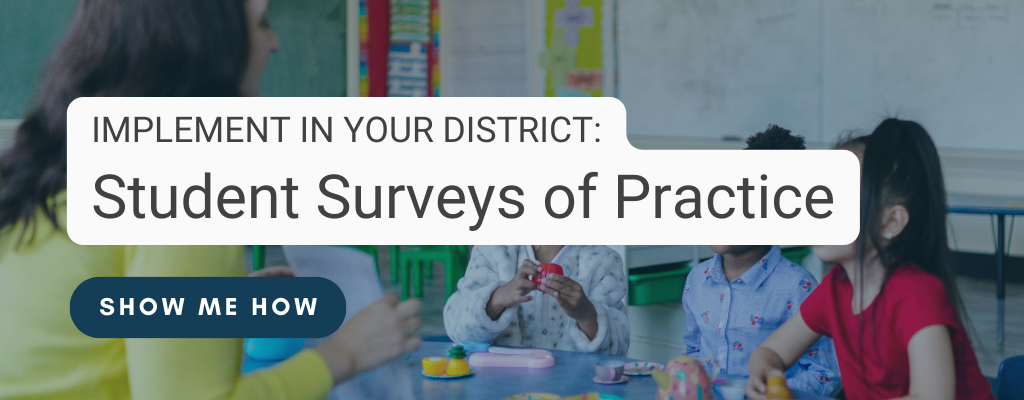
Improve Student Achievement by Measuring the Student Experience
Improve Student Achievement by Measuring the Student Experience
Think back to some of your most meaningful school memories: the teacher who encouraged your love of writing; the art and music classes you enjoyed; the robotics club that inspired you to pursue a STEM career; the friends and classmates that made you look forward to—or avoid—going to school each day. How do you think these experiences shaped your educational path, from elementary school to college to career?
The experiences students have through their educational journey can significantly impact the ways they approach and engage in learning, both in school and beyond. In this article, we explore the many facets of student experience, its relevance to student achievement and positive learning outcomes, and different approaches to measuring it.
What is Student Experience?
Student experience encompasses the interactions, perceptions, and moments that students encounter within and outside the classroom. Key elements of the student experience include:
- academic engagement, or active involvement, interest, participation, and attendance in academic activities;
- interactions with peers, teachers, and other members of the learning community;
- social and emotional well-being and support systems at school;
- feelings of belonging or connectedness with the school community;
- the instruction, assessment, and learning support they receive; and
- school environment and resources, such as school climate and the availability of facilities and supplies for learning.
Collectively, these elements contribute to students’ overall learning and growth in an educational environment.
The Impact of Positive Student Experience
Research consistently suggests that a positive student experience is related to positive academic outcomes. For instance, when students are actively engaged in their learning, they tend to be more focused, persistent, and invested in their academic work, contributing to higher levels of academic achievement. In fact, research shoes that academically engaged students demonstrate higher levels of achievement across various subject areas and grade levels (Fredricks, Blumenfeld, & Paris, 2014). Research also demonstrates that a supportive and inclusive educational environment which fosters positive social relationships and a sense of belonging and connectedness to their school community can enhance students’ confidence, engagement, and motivation. (Wang & Eccles, 2013). And, when students feel safe and emotionally supported, they are better equipped to engage in learning. All of these factors can contribute to improved academic achievement. (Hill, Bloom, Black, & Lipsey, 2008).
Positive interactions between students and educators can also have a meaningful impact on student learning. When teachers establish supportive, respectful, and caring connections with their students, it creates an environment conducive to learning, often leading to improved academic outcomes. And when teachers offer personalized and differentiated instruction and support, students are more likely to be actively involved in their learning. .
A school’s overall environment, climate, and culture can influence student experience and achievement. A positive, inclusive, and supportive school environment that values diversity, promotes high expectations, and provides adequate resources can contribute to better academic outcomes. Students’ satisfaction with their learning environment has been positively associated with their academic performance (Hsieh & Huang, 2018).
By fostering a positive student experience through engagement, support, belonging, and personalized learning, conditions are in place for improved student success and academic achievement.
Measuring Student Experience
Education researchers utilize various approaches and tools to measure student experience. These measures often aim to capture different elements of student experience and educational journeys. These methods might focus on collecting qualitative data, quantitative data, or both. Additionally, various aspects of the student experience may be measured through different stakeholders—not just students, but also their teachers, principals, and parents or guardians.
Common qualitative approaches include individual and focus group interviews, which allow researchers to ask and gather in-depth information about students’ thoughts, feelings, and experiences related to their learning. These interviews provide rich, nuanced insights into students’ perspectives on various dimensions of their educational experience. Researchers may also conduct systematic observations of students' behaviors and interactions within educational settings. This method involves observing students in classrooms, during group activities, or in other educational contexts. Such observations provide valuable information about student engagement, social dynamics, and classroom climate.
For quantitative data, researchers frequently use surveys or questionnaires to collect information on students’ perceptions, attitudes, and experiences. These instruments often use questions with rating scales. These surveys can gather qualitative data through open-ended questions that assess different aspects of the student experience, such as academic engagement, satisfaction, sense of belonging, and academic support. Examples of these types of surveys include
- Tripod’s 7Cs student perception survey, which provides insights into the quality of teacher instruction;
- SEL survey suite, which measures students’ social and emotional strengths and areas for improvement; and
- DEI survey, which captures student perceptions of school climate in general and specific to diversity, equity, and inclusion.
Mixed-method approaches such as the ones above that combine qualitative and quantitative methods, scan help to gain a comprehensive understanding of the student experience. By triangulating data from different sources, researchers can validate and enrich their findings.
It is important to note that the specific approaches and tools used to measure student experience may vary depending on one’s research goals, context, and target population.
Prioritizing the Student Experience
School and district leaders can leverage insights into their students’ experiences to help design policies, curricula, and practices that will enrich the educational environment. By prioritizing a positive student experience, we can create supportive school communities that enhance learning, engagement, and overall student success.
Are you interested in gathering data about student experiences in your school or district? Our consultants have the knowledge and experience to help you get started! Contact us today.
References
Fredricks, J. A., Blumenfeld, P. C., & Paris, A. H. (2014). School engagement: Potential of the concept, state of the evidence. Review of Educational Research, 74(1), 59-109.
Hill, H. C., Bloom, H. S., Black, A. R., & Lipsey, M. W. (2008). Empirical benchmarks for interpreting effect sizes in research. Child Development Perspectives, 2(3), 172-177.
Hsieh, P. H., & Huang, W. L. (2018). College students' satisfaction with the learning environment and its association with students' academic achievement. Assessment & Evaluation in Higher Education, 43(7), 1129-1142.
Wang, M. T., & Eccles, J. S. (2013). School context, achievement motivation, and academic engagement: A longitudinal study of school engagement using a multidimensional perspective. Learning and Instruction, 28, 12-23.






